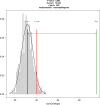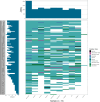Variation in abundance of predicted resistance genes in the Brassica oleracea pangenome
- PMID: 30230187
- PMCID: PMC6419861
- DOI: 10.1111/pbi.13015
Variation in abundance of predicted resistance genes in the Brassica oleracea pangenome
Abstract
Brassica oleracea is an important agricultural species encompassing many vegetable crops including cabbage, cauliflower, broccoli and kale; however, it can be susceptible to a variety of fungal diseases such as clubroot, blackleg, leaf spot and downy mildew. Resistance to these diseases is meditated by specific disease resistance genes analogs (RGAs) which are differently distributed across B. oleracea lines. The sequenced reference cultivar does not contain all B. oleracea genes due to gene presence/absence variation between individuals, which makes it necessary to search for RGA candidates in the B. oleracea pangenome. Here we present a comparative analysis of RGA candidates in the pangenome of B. oleracea. We show that the presence of RGA candidates differs between lines and suggests that in B. oleracea, SNPs and presence/absence variation drive RGA diversity using separate mechanisms. We identified 59 RGA candidates linked to Sclerotinia, clubroot, and Fusarium wilt resistance QTL, and these findings have implications for crop breeding in B. oleracea, which may also be applicable in other crops species.
Keywords: Brassica oleracea; PAV; Brassicaceae; RGAs; pangenomics; resistance genes.
© 2018 The Authors. Plant Biotechnology Journal published by Society for Experimental Biology and The Association of Applied Biologists and John Wiley & Sons Ltd.
Conflict of interest statement
The authors have no conflicts of interest to declare.
Figures




References
-
- Alamery, S. , Tirnaz, S. , Bayer, P. , Tollenaere, R. , Chaloub, B. , Edwards, D. and Batley, J. (2018) Genome‐wide identification and comparative analysis of NBS‐LRR resistance genes in Brassica napus . Crop Pasture Sci. 69, 72–93.
Publication types
MeSH terms
LinkOut - more resources
Full Text Sources
Other Literature Sources
Molecular Biology Databases

